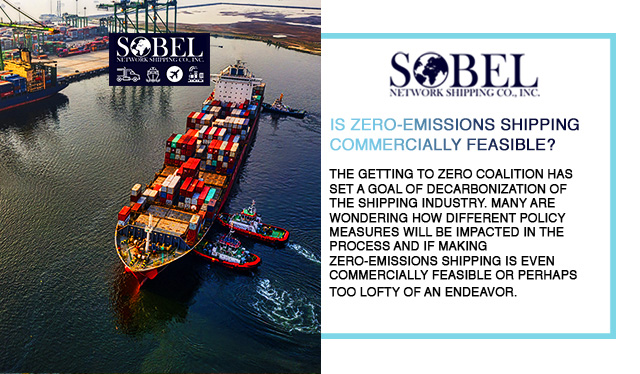The Getting to Zero Coalition has set a goal of decarbonization of the shipping industry. Many are wondering how different policy measures will be impacted in the process and if making zero-emissions shipping is even commercially feasible or perhaps too lofty of an endeavor.
The World Economic Forum, Friends of Ocean Action, and the Global Maritime Forum all belong to the Getting to Zero Coalition. The report released was drafted in partnership with the maritime consultancy UMAS.
Projections show that by 2050 the shipping-related greenhouse gas emissions will more than likely increase by 90 to 130% The International Maritime Organization set a target to reduce their emissions by at least 50% by 2050. Other shipping companies have followed their lead and set their own net-zero emission targets – many striving to lower emissions even sooner.
The report went on to explore the need for urgent policy changes to help close the competitive gap by making zero-emission fuels affordable and cheaper than conventional shipping fuels.
Carbon Pricing Pathways
A dual set of carbon pricing pathways have been modeled. One shows emissions being reduced by 50% and another one shows emissions lowered to zero. With both, the emissions will peak in 2030 and depend on carbon pricing which is set to begin in 2025 at $110 per metric ton.
The price of carbon averages $173 per ton during the 50% emissions reduction projection and it is set at $191 per ton during the 100% reduction plan. By 2050 the carbon emissions price would reach $264 and $360. Even though that number is extreme, the effects of climate change and the lack of real action needed to reduce emissions will also have extreme consequences, so it becomes a catch 22 situation with all sides struggling to achieve actual results.
The decarbonization path is smoother if the price is set higher than $q11 which will help alleviate any economic shocks from the sharp price increases. The amount of reduction in emission could be achieved with reduced carbon prices if all of the funds gathered are then directed towards funding the deployment of zero-emission tech and various fuel options.
Transition, Timing, and Speed Considerations
During the transition, the timing and speed will help ease the cost of shipping decarbonization. More gradual changes will reduce the disruptions in the sectors and halt any asset stranding.
Regulatory measures like technology, performance, emissions, and product standards will also reduce emissions. Performance and emissions stand out as the least restrictive and they do not hinder which techniques or technologies are used to achieve the standards. It should be noted that revenue is not collected with standards as they are with carbon prices, so it is difficult to ensure a transition to reduce emissions technologies, so they are more equitable.
Shipping fuels must reduce emissions but also be cost-effective to be sustainable. Isabelle Rojan, the principal consultant at UMAS and the author of the report stated, “Decarbonization policy for shipping needs to be as much about equity and fairness as it is about climate change mitigation. Vast inequalities exist globally, many of which are worsening in the face of climate change. With careful policy design and the use of carbon pricing revenues, we can ensure that maritime climate policies do not exacerbate these inequalities. Furthermore, embedding equity into policy measures will help secure the multilateral agreement that is urgently needed.”
Voluntary initiatives to reduce emissions in shipping do not have any significant negative impacts on companies or regions. Instead, they actually provide a competitive advantage. Alison Shaw, a research associate at UCL and co-author of the report stated,
“This year will be critical for decisions on climate policy in the IMO. Our report shows that there is no single perfect policy and that a successful transition will likely hinge on developing and deploying a mix of policies which can address various aspects of the transition. … The sooner policymakers can surmount this challenge together, the better for the transition, the industry, and the environment.”
Freight forwarding in Miami remains dedicated to helping reduce carbon emissions while still providing superior commercial shipping services to clients.


